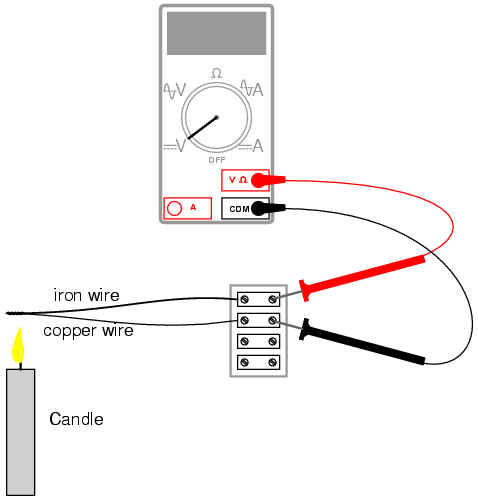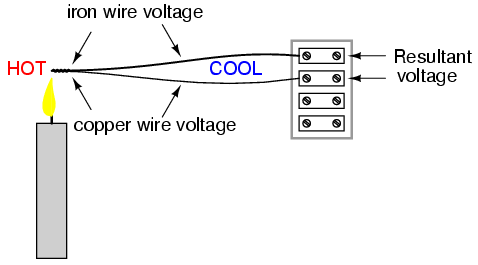Thermoelectricity
PARTS AND MATERIALS
Iron wire may be obtained from a hardware
store. If some cannot be found, aluminum wire also works.
CROSS-REFERENCES
Lessons In Electric Circuits, Volume
1, chapter 9: "Electrical Instrumentation Signals"
LEARNING OBJECTIVES
SCHEMATIC DIAGRAM

ILLUSTRATION

INSTRUCTIONS
Twist one end of the iron wire together with
one end of the copper wire. Connect the free ends of these
wires to respective terminals on a terminal strip. Set your
voltmeter to its most sensitive range and connect it to the
terminals where the wires attach. The meter should indicate
nearly zero voltage.
What you have just constructed is a
thermocouple: a device which generates a small voltage
proportional to the temperature difference between the tip
and the meter connection points. When the tip is at a
temperature equal to the terminal strip, there will be no
voltage produced, and thus no indication seen on the
voltmeter.
Light a candle and insert the twisted-wire
tip into the flame. You should notice an indication on your
voltmeter. Remove the thermocouple tip from the flame and
let cool until the voltmeter indication is nearly zero
again. Now, touch the thermocouple tip to an ice cube and
note the voltage indicated by the meter. Is it a greater or
lesser magnitude than the indication obtained with the
flame? How does the polarity of this voltage compare with
that generated by the flame?
After touching the thermocouple tip to the
ice cube, warm it by holding it between your fingers. It may
take a short while to reach body temperature, so be patient
while observing the voltmeter's indication.
A thermocouple is an application of the
Seebeck effect: the production of a small voltage
proportional to a temperature gradient along the length of a
wire. This voltage is dependent upon the magnitude of the
temperature difference and the type of wire. Directly
measuring the Seebeck voltage produced along a length of
continuous wire from a temperature gradient is quite
difficult, and so will not be attempted in this experiment.
Thermocouples, being made of two dissimilar
metals joined at one end, produce a voltage proportional to
the temperature of the junction. The temperature gradient
along both wires resulting from a constant temperature at
the junction produces different Seebeck voltages along those
wires' lengths, because the wires are made of different
metals. The resultant voltage between the two free wire ends
is the difference between the two Seebeck voltages:

Thermocouples are widely used as
temperature-sensing devices because the mathematical
relationship between temperature difference and resultant
voltage is both repeatable and fairly linear. By measuring
voltage, it is possible to infer temperature. Different
ranges of temperature measurement are possible by selecting
different metal pairs to be joined together. |